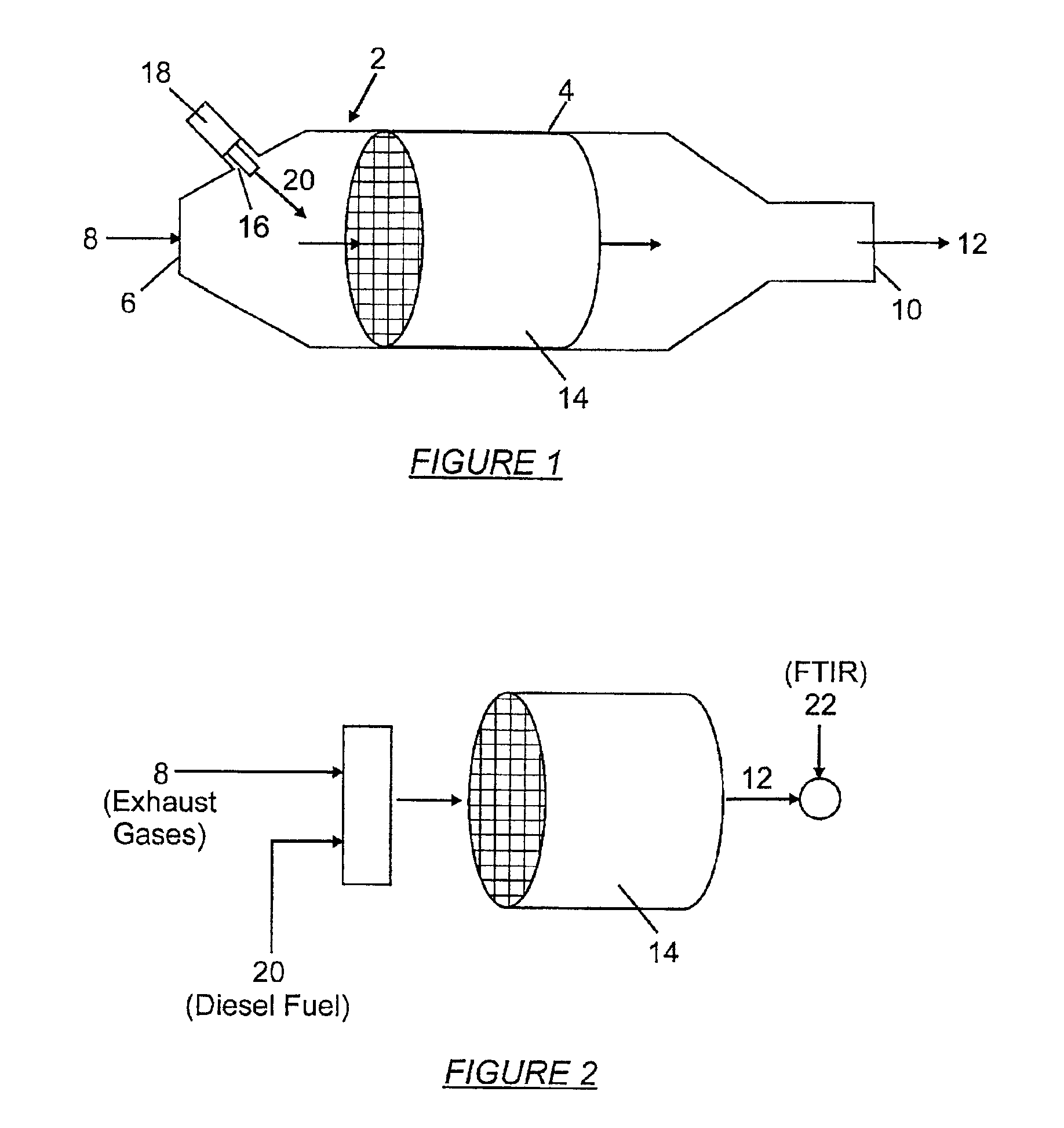Reduction of nitrogen oxides in diesel exhaust gases and fuel injection system
- Summary
- Abstract
- Description
- Claims
- Application Information
AI Technical Summary
Benefits of technology
Problems solved by technology
Method used
Image
Examples
example 1
[0023]In one embodiment of the invention, the deNOx catalyst 14 (shown in FIG. 1) includes one or more perovskite compounds represented by the formula AB1-xPMxO3, where A is a group III or group IV rare-earth metal, B is a group III or group IV transition metal, PM is a precious metal, O is oxygen. Preferably, x ranges from 0.01 to 0.3. To obtain a relatively high surface area, the perovskite-based deNOx catalyst can be synthesized by a method called the Pechini process. For a C1 deNOx catalyst based on a perovskite compound LaMn0.9Ru0.1O3, the Pechini process involves dissolving lanthanum nitrate in aqueous manganese nitrate and adding citric acid and ethylene glycol to the mixture to obtain a chelated complex. The ratio of citric acid to lanthanum (La) and manganese (Mn) is one to one, e.g., two moles of citric acid to one mole of LaMn0.9Ru0.1O3. The amount of ethylene glycol to add to the mixture is calculated by the following equation:
weight of ethylene glycol=1.5×weight of citr...
example 2
[0028]In another embodiment of the invention, the deNOx catalyst 14 includes a support material impregnated with one or more precious metals. Examples of precious metals suitable for use in the invention are rhodium (Rh), platinum (Pt), palladium (Pd), iridium (Ir), and ruthenium (Ru). The support material is made of a metal oxide or a combination of two or more metal oxides. A C2 deNOx catalyst is attained by impregnation of non-stoichiometric titanium oxide (TiO2-x) with Rh and Pt. In this example, x is 0.25. The non-stoichiometric titanium oxide is obtained by mixing one mole of Ti2O3 and two moles of TiO2 and then firing the mixture at 1100° C. for 5 hours in forming gas (6 percent H2 / 94 percent N2). The fired mixture is impregnated with Pt by dipping repeatedly in (NH3)4Pt(NO3)2 solution. The resulting mixture is dried in an oven at 110° C. to 120° C. for 24 hours and then fired for three hours in air at 560° C. The Pt—TiO2-x mixture is impregnated with Rh by dipping repeatedly...
example 3
[0032]In another embodiment of the invention, the deNOx catalyst 14 (shown in FIG. 1) includes a zeolite impregnated with one or more precious metals. Examples of precious metals suitable for use in the invention are Pt, Rh, Ru, Pd, and Ir. As previously mentioned, zeolites are silicates consisting of interlocking tetrahedrons of SiOx and AlOy. An example of a zeolite that is suitable for use in the invention is ZSM-5. For high temperature stability, the silica to alumina mole ratio in the zeolite should be high. For example, for ZSM-5, the silica to alumina mole ratios is at least about 25, and preferably at least about 55. One source of ZSM-5 zeolite is supplied by Exxon Mobil Corp., Dallas, Tex., under the trade name MZ-12. Other examples of zeolites evaluated for use in the invention include mesoporous crystalline material (MCM-41), ultrastabilized Y (USY), NaY, H-ferrierite, and AlPO4-5. In some embodiments of the invention, the zeolites are loaded with transition metals, e.g.,...
PUM
| Property | Measurement | Unit |
|---|---|---|
| Fraction | aaaaa | aaaaa |
| Fraction | aaaaa | aaaaa |
| Fraction | aaaaa | aaaaa |
Abstract
Description
Claims
Application Information
 Login to View More
Login to View More - Generate Ideas
- Intellectual Property
- Life Sciences
- Materials
- Tech Scout
- Unparalleled Data Quality
- Higher Quality Content
- 60% Fewer Hallucinations
Browse by: Latest US Patents, China's latest patents, Technical Efficacy Thesaurus, Application Domain, Technology Topic, Popular Technical Reports.
© 2025 PatSnap. All rights reserved.Legal|Privacy policy|Modern Slavery Act Transparency Statement|Sitemap|About US| Contact US: help@patsnap.com


